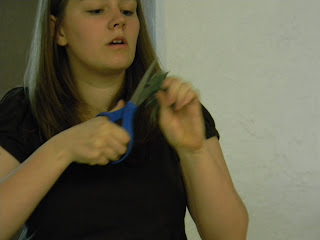The most important thing to remember for this first step is to cover ALL facial hair with vaseline. That includes eyelashes and sideburns.
You will want to put a drop cloth under your volunteers and cover your table with a tablecloth or newspaper. Have a bowl of water ready. You will also want to take a roll of plaster of paris gauze and cut it into narrow strips of different lengths. Make sure you put two or three small pieces aside for the nose later.
Cover your volunteer's hair with plastic wrap and make sure that all hair is completely covered. If there is any showing near the face then cover with vaseline.
Starting on the top of the head, cover the whole face with strips to form a bowl. As it hardens the volunteer will feel it cool and start to separate from their face. Make sure that you have 2-3 layers of guaze on the face.
It is very important to not cover the nose. We will do that later.
Wait for it to completely dry. This should only take about 5-10 minutes.
Have the volunteer pull their head back as you pull the plaster face forward.
Cover the nose holes with the 2-3 strips you set aside.
Once it is completely dry set it in a box of cat liter so that it will hold its shape. Completely cover the inside with vaseline. Fill with plaster. You can buy this in big bags at any hardware store. Let it sit for a few days until it is completely dry and then separate the shell from the plaster. Now you have an exact copy of your face. Now you can use oil based clay to shape your mask. Make sure that you have plastic wrap between the clay and the cast of your face.
Put paper/newspaper through a shredder. The finer the shred the easier it will be to manipulate it later.
I use wallpaper paste for pre-pasted wallpaper for the glue. You can find this at Home Depot for $5.
I know this sounds gross but you want the paper/glue mixture to be the texture of cat vomit. Eww. I know.
Put a thick layer of paper mache on the clay version of your mask. Make sure that there is plastic wrap between the clay and the paper mache.
Put a layer of paper towel over the completed form and cover the paper towel with more glue. Let it completely dry. This can take a few days. Then you can paint it any way you want. I always start by spray painting the mask black and then add color.






















































